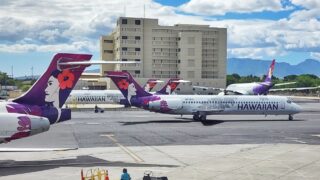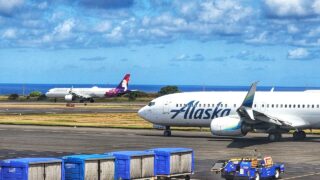One year after Alaska Airlines bought Hawaiian Airlines for $1.9 billion, the dream of a global Hawaiian brand is officially dead. Alaska executives have abandoned Hawaiian’s international expansion plans, choosing instead to fold everything into their Seattle-focused global strategy.
That leaves many to question what was lost in the process.
How Hawaiian Airlines almost became a global brand.
Hawaiian’s brand carried aspiration and an identity few U.S. airlines have ever matched. The orchid Pualani logo, island-inspired colors, and its unique and endearing sense of place created recognition far beyond Honolulu and throughout the world. When Hawaiian entered new markets, such as New York or Tokyo, the buzz was immediate. At one point, Japan routes alone represented nearly 20 percent of the airline’s revenue, and Hawaii tourism officials viewed Hawaiian as the state’s bridge to Asia.
As we documented in “How Hawaiian Airlines’ Pualani Branding Took Aloha Global,” the Flower of the Sky logo became an international ambassador that extended beyond flights, in cities from New York to Tokyo, and Beijing to Sydney.
Hawaiian’s branding was more than a marketing exercise. It carried cultural weight and immediately set the airline apart in ways competitors could not replicate. It was both an American brand success story, rare in the airline world, and a Hawaiian cultural story that resonated wherever the planes flew.
In Asia, especially, where brand prestige matters, Hawaiian’s identity gave it a unique runway, even before it had the proper long-haul fleet to compete effectively. An expanded Hawaiian presence in Japan, Korea, and beyond might have positioned Hawaii as more than a leisure stop. It could have been a global niche carrier with a distinctive aura.
Readers have told us again and again that Hawaiian once felt like a “glimpse of paradise” before you even landed. That aspirational identity, repeated in hundreds if not thousands of comments, clearly mattered.
Alaska Airlines was built for Seattle, not Singapore.
Alaska Airlines is a strong and competitive West Coast carrier, known for reliability and efficiency. Its brand works domestically but has never translated into international prestige. Outside of Mexico, Alaska’s global footprint has been minimal.
Competing with carriers like JAL, ANA, or Singapore Airlines in Asia requires not only superior service and planes but also a strong marketplace presence. That’s an area Alaska has never seriously attempted to play in.
As we detailed in Hawaiian Was Building The Future Of Flying Before It Fell Apart, Alaska’s approach has been about assimilation rather than elevation. The buyout of Hawaiian was not about preserving a unique identity, but rather about integrating it into Alaska’s existing and future mold. That approach reflects what some see as corporate arrogance. It is the belief that Alaska’s way is always the right way, even when it ignores the nuances of international markets and the emotional weight of the Hawaiian brand.
Can Alaska crack Asia’s billion-dollar market?
Hawaiian’s cutbacks in Asia are already painful. Service to Fukuoka and Sapporo ended. Flights to Seoul and Haneda were reduced. Meanwhile, Japan’s ANA and JAL now dominate Hawaii lift, controlling most of the seats between the two regions. Hawaiian could not hold the line alone, but its brand still carried recognition and opportunity.
Since Hawaiian no longer reports results as a standalone airline, it isn’t easy to know precisely how its Asia flights are performing under Alaska. DOT traffic data still shows Hawaiian-coded operations, but those results are now buried inside Alaska’s group reporting. Travelers often remark on half-empty international cabins, which raises questions about how much of the so-called turnaround is tied to brand strength versus group accounting.
Alaska has no similar resonance. Without Hawaiian’s name, Alaska becomes just another U.S. airline abroad, functional but forgettable. That is the stark difference from what Hawaiian once represented in Asia.
Reader voices: what we are losing.
Readers have been outspoken about what this buyout means, and their voices capture the loss better than anything else. Abner, a longtime reader, summed it up: “Alaska and international market, I say Alaska was the wrong choice. They should have extended the Hawaiian brand, not the Alaska brand. At least Hawaiian had some semblance of an upscale feel. Alaska can’t and won’t attract much from long-haul Asian competitors.”
JohnW, one of our most prolific commenters, expanded on that point: “Whenever Hawaiian Air entered a new market far from Hawaii the name created a lot of buzz that other carriers do not. Whether in NYC (it was given a segment on Good Morning America as I recall) or in foreign countries it is always a brand that stood out in ways Alaska never could. There is a worldwide mystique surrounding Hawaii and using the Hawaiian brand would give Alaska a substantial marketing advantage. Even in markets that do not serve Hawaii.”
And Sunil Rao took it further: “Absolutely. The word Hawaiian evokes a lot more excitement than Alaska. Don’t count on Alaska Airlines management to realize this. They ruined Virgin America, which had much better brand standing than Alaska. Their whole promise was to expand San Francisco as another hub, which they failed miserably.”
Camm W added a further provocative twist: “It never occurred to anyone to retire the Alaska name and become one global Hawaiian Airlines? Problems solved all the way around. People dream of Hawaii, not Alaska. Alaska has no recognition in Asia and the South Pacific.
Keeping the name Hawaiian would make that whole brand an instant powerhouse if they don’t hire another idiot like Peter Ingram to ruin it. This merger has the potential to shine, but the Alaska name must be retired.”
Together, these perspectives show a pattern. Alaska has not just struggled with brand building. It has consistently chosen to bury brands that arguably carried more value than its own. Virgin America was one example. Hawaiian Airlines is poised to be next.
What could have been.
It is true that Hawaiian’s international growth was never guaranteed. The canceled A350 order, repeated Dreamliner delays, and mounting financial pressures showed how fragile the airline had become.
Without Alaska’s buyout, it is entirely possible that Hawaiian would have slipped into bankruptcy, leaving nothing at all. Alaska now says the Hawaiian aircraft assets posted a positive margin for the first time since 2019. No one will ever know if Hawaiian could have found a different backing that preserved its brand while returning it to health.
Yet even with those struggles, its brand carried weight; Alaska never will. Imagine a Hawaiian Airlines that had partnered more closely with Asian carriers, used its Dreamliners to anchor premium routes, leaned into its cultural identity, and carefully expanded abroad. That vision might have cemented Hawaii’s role in the global aviation market in a way Alaska cannot replicate.
For more on how this plays into the broader integration, see How Long Will Hawaiian Alaska Dual Branding Really Last and Big Planes, Big Dreams, And The Mistakes That Broke Hawaiian Airlines.
Do you think Hawaiian Airlines could have become a global player if its brand had been nurtured instead of buried? Or was it always destined to be swallowed by a larger carrier in the dog-eat-dog airline world? Share your thoughts below.
Photo Credit: Beat of Hawaii in NYC to celebrate the start of HNL-NYC service many years ago.
Get Breaking Hawaii Travel News







I would like to know what the Hawaiian load factors are now on their long haul flights. Even to JFK.